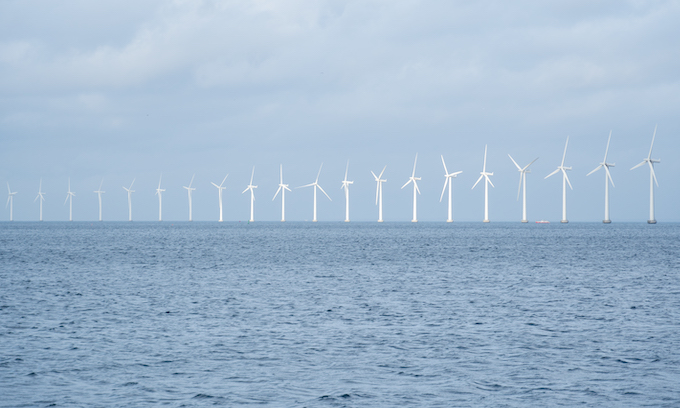Federal officials are looking into leasing a massive amount of offshore land for wind projects about 24 nautical miles off the coast of Galveston.
If developed, the Wind Energy Area would cover 546,645 acres — larger than the city of Houston — which officials with the Bureau of Ocean Energy Management say could produce enough electricity to power about 2.3 million homes.
A second project has been proposed about 56 nautical miles off the coast of Lake Charles, which would cover 188,023 acres. Bureau of Ocean Energy Management officials said that project could produce enough power for 799,000 homes.
Bureau officials said it is still early in the process, and the wind energy area proposal is still a draft. They are asking for public comments on the proposed area and leases on their website. They will hold two virtual town halls on the proposals Aug. 9 and 11.
“We are in the early planning stages for offshore wind leasing in the Gulf of Mexico. Once the final wind energy area or areas have been identified, the next step is to propose a lease sale for public comment either later this year or early next year,” said John Filostrat, a spokesman for the bureau’s Gulf of Mexico office.
The federal officials said it would be up to states and the wind developers to determine whether the electricity generated would be connected with the Electric Reliabiliy Council of Texas or neighboring East Coast operators.
It would be up to the Coast Guard to determine whether commercial or recreational boats — including commercial fishing and shrimping operations — could enter the waters near the wind turbines, bureau officials said, adding that they have already held several meetings with fishing groups and associations this year as they’ve planned the leases.
As a result, they said, they have already carved out parcels from the lease area to leave bare for shrimping operations to continue.
The announcement is part of a Biden administration initiative to help develop 30,000 megawatts of offshore wind generation by 2030, a jaw-dropping increase from the 42 megawatts of electricity produced by the only two offshore wind farms currently in operation nationwide. Those two projects are in state waters, and there are no projects currently operating in federal waters.
Fifteen more projects are in the permitting phase, and eight states have set goals to procure a combined 39,298 megawatts by 2040, according to the U.S. Department of Energy. One megawatt is enough to power about 200 homes on a hot summer day.
Wind energy along the Gulf Coast tends to be strongest closer to Corpus Christi and Brownsville but tapers off by the time it reaches Florida, according to a study by the Bureau of Ocean Energy Management.
Gulf Coast winds still aren’t as forceful or as consistent as those off the East Coast, where existing offshore wind farms are, said Michael Matthews, U.S. representative for the World Forum Offshore Wind, which promotes wind energy around the globe.
“It isn’t fantastic,” Matthews said of the wind in the Gulf in an October 2021 interview. “It’s OK. It’s good for offshore wind, but it’s nothing like the North Sea in Europe or the Northeast (United States).”
The Gulf, however, is attractive to wind developers because of its existing offshore infrastructure, Matthews said.
Requesting comment for draft leases is part of the first of four stages of developing offshore wind power. The second stage is selling the leases and doing more detailed environmental impact studies, the third is site assessments, and the fourth is construction and operation. It can take about 10 years from the initial stage of offshore wind development before turbines are operational.
Plans for offshore wind developments in the Gulf lag behind plans along the East Coast. Leases for offshore wind have already gone up for sale in North Carolina, New Jersey, New York and Massachusetts.
If the offshore wind power flows into ERCOT, it could help the grid meet the record-breaking and growing demand the nonprofit grid operator has seen in recent months.
Some state officials, including ERCOT interim CEO Brad Jones and Gov. Greg Abbott, have blamed low output from the state’s onshore wind fleet for tight grid conditions this summer, although it has long been known that wind blows less on hot summer days and is usuallu at its best during winter and in the evenings. Offshore wind, however, performs much better during the middle of hot days.
© Copyright (c) 2022 Austin American-Statesman
—-
This content is published through a licensing agreement with Acquire Media using its NewsEdge technology.



















What utter bravo sierra.
Texas has enough oil in the ground to energize this state for the next 100 years. When the wind goes dead the oil never does. Let some energy poor state like New York or Chicago Illinois get them. Dark nights make for great Democat politics of night time social wealth redistribution and more fit the needs of Democrat run states and cities than places like Texas. Just another Biden administration politically motivated idea to deplete the strength of Self-governing states and cities to give them equal distribution of the failure now provided by States like Illinois, New York and California. Maybe they could be used to electrify the fences on our Southern Border with Mexico.
And when the next hurricane hits?
Have ANY wind turbans, been tested to see how they’d handle a Cat 2 hurricane (Or F2 twister), let alone a Cat 5??
So Far they have survived Hurricane Biden, a category 5 blowhard.
BUT can the rest of the nation?
I hope it’s smack dab in the path of a tornado.
Why is there NO Mention of the COSTS of this insane project? I am sure fossil fuels would work out to be much cheaper. No mention of the number of years to recoup the dollars used on this project either.
Notice that Dems and big P Progressive Republicans (a.k.a. RINOs) never mention the cost of anything. They use Modern Monetary Theory to claim that they can just print money with no problem. But that assumes that economy would immediately increase in production to match the new fiat money. But it doesn’t work that way in real life.